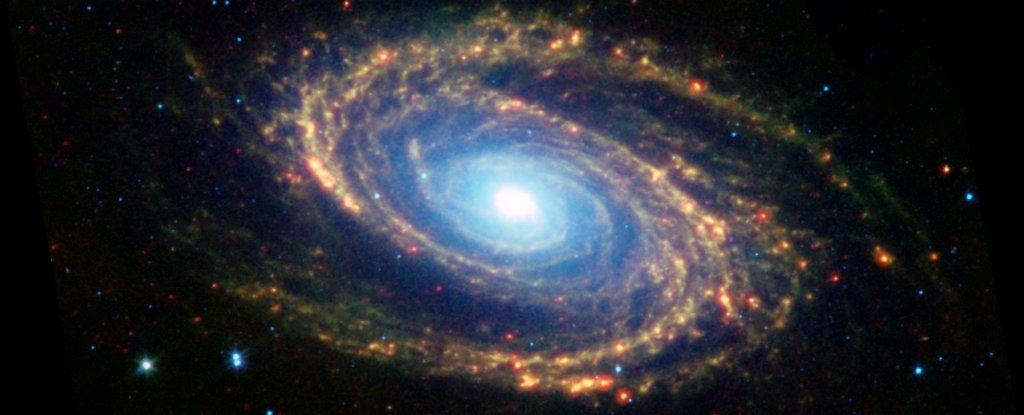Products You May Like
A newly discovered repeating fast radio burst (FRB) named FRB 20200120E is deepening the mystery of these already deeply mysterious space signals.
Astronomers have tracked its location to a galaxy 11.7 million light-years away, which makes it the closest known fast radio burst, 40 times closer than the next-closest extragalactic signal. But it also appears in a globular cluster – a clump of very old stars, not the sort of place at all one might expect to find the type of star spitting out FRBs.
Its discovery suggests a different formation mechanism for these stars, suggesting that FRBs could emerge from a wider range of environments than we thought.
FRBs have been deviling scientists since the first one was discovered back in 2007. They consist of extremely powerful signals from deep space millions of light-years away, some discharging more energy than 500 million Suns and only detected in radio wavelengths.
Yet these bursts are shockingly brief, less than the blink of an eye – mere milliseconds in duration – and most of them don’t repeat, making them very hard to predict, trace, and therefore understand.
By analyzing the fine structure of these radio signals, astronomers have been homing in on the type of object they thought might cause them, with compact objects such as neutron stars the leading theory. Then, last year, came a massive breakthrough. An FRB was finally detected from inside the Milky Way galaxy, emitted by a magnetar.
Magnetars – of which only 24 have been confirmed to date – are a rare type of neutron star, the collapsed core of a dead star that started out between 8 and 30 times the mass of the Sun. Neutron stars are small and dense, about 20 kilometres (12 miles) in diameter, with a maximum mass of about two Suns.
Magnetars, as the name suggests, add something else to the mix: an absolutely insaneballs magnetic field – around a quadrillion times more powerful than Earth’s magnetic field, and a thousand times more powerful than that of a normal neutron star.
This brings us back to FRB 20200120E. It’s a minority among FRBs, one that repeats, but aside from that fits the profile perfectly. Because it repeats, though, astronomers were more easily able to pinpoint the location on the sky from which it originated. By analyzing other properties of the signal, they were able to determine that it had traveled a relatively short distance.
This brought them, earlier this year, to a grand design spiral galaxy called M81, although with a degree of uncertainty. More specifically, the researchers believed they had tracked FRB 20200120E to a globular cluster.
In a new preprint currently awaiting peer review, a team of astronomers have confirmed that location.
Here’s why that’s a problem. Globular clusters are compact groups of stars that tend to be very old and long-lived, as well as low mass, none greater than the mass of the Sun. All their stars are thought to have formed from the same cloud of gas at the same time; just like a small town, these stars then live out their mostly quiet existences together.
Neutron stars, as we mentioned earlier, tend to form from higher mass stars, which also tend to have much shorter main-sequence (hydrogen-burning) lifespans – those of the OB type. So, as a general rule of thumb, you wouldn’t expect to find neutron stars or magnetars in a globular cluster.
“Here we conclusively prove that FRB 20200120E is associated with a globular cluster in the M81 galactic system, thereby confirming that it is 40 times closer than any other known extragalactic FRB,” the researchers wrote.
“Because such globular clusters host old stellar populations, this association challenges FRB models that invoke magnetars formed in a core-collapse supernova as powering FRB emission.”
Fear not, however – because there is an interesting precedent.
Every now and again, a globular cluster has been found to host a type of rapidly rotating neutron star known as a millisecond pulsar. Because globular clusters are so densely populated, stars can interact and even collide with each other, producing objects such as low-mass X-ray binaries and pulsars.
According to the research team, this introduces other interesting mechanisms for magnetar formation beyond the core-collapse supernova of a massive star. A low-mass white dwarf interacting with and accreting material from another star could gain enough mass to collapse into a neutron star; or two white dwarfs could merge, to the same end.
It’s also possible that the source of the FRB isn’t a magnetar at all, but a low-mass X-ray binary, such as a white dwarf and a neutron star, or a neutron star and an exoplanet. It may also be an accreting black hole. The evidence for these explanations is lacking – there’s no X-ray or gamma-ray activity that typically would accompany these systems – but they still can’t be ruled out.
Whatever the answer is, though, it seems like FRB 20200120E is set to shake things up. Either it will teach us something new about star interactions in globular clusters, or it will give us a new formation channel for FRBs.
Since it is a repeating FRB, so close to us, it represents a rare opportunity to probe these mystery signals in detail.
The paper is available on preprint server arXiv.
